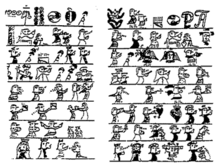Pomier Caves

The Pomier Caves are a series of 55 caves located north of San Cristobal in the south of the Dominican Republic. They contain the largest collection of 2,000-year-old rock art in the Caribbean primarily by the Taino, but also by the Carib and the Igneri, the pre-Columbian indigenous inhabitants of the Bahamas, Greater Antilles, and some of the Lesser Antilles. These caves have been damaged by the uncontrolled mining of limestone nearby.[1][2]
Importance
Archaeologists have described the importance of preserving these caves which were first discovered in 1851. The caves contain approximately 6,000 drawings, carvings and pictographs of birds, fish, reptiles, and human figures. The paintings were drawn with charcoal mixed with animal fat. Archaeologists say that the paintings have been protected by the natural humidity provided by the depth of the caves as they extend down to 1,000 feet below sea level.[3]
Protection
In 1996, the Anthropological Reserve of Cuevas de Borbón in San Cristóbal was enlarged to protect the El Pomier caves from limestone quarrying. This raised their protection category, and included them in the National System of Protected Areas, through the General Law on Environmental and Natural Resources, Law 64-00, which also gave instructions to the Secretariat de Estate supervising its application.[4][5]
Given the international importance of these caves for the study of Amerindian groups that inhabited the Caribbean Islands for nearly 8,000 years prior to the arrival of western culture, the caves are being considered for the unique category of Capital Prehistoric De Las Antillas (Prehistoric Capital of the Antilles) and the rehabilitation of one of its caves and its surrounding area to match this new category.
See also
Notes
- ↑ "Dominican Republic Taino Indian Series". Archived from the original on 2007-10-06. Retrieved 2007-07-11.
- ↑ "Taíno Cave Art Under Siege". Retrieved 2007-07-11.
- ↑ "Ancient cave art threatened by mining in Dominican Republic". Archived from the original on 2007-10-16. Retrieved 2007-07-10.
- ↑ "Dominican Republic.com - Flora and Fauna". Archived from the original on 2007-06-08. Retrieved 2007-07-11.
- ↑ "Daily News - Domingo Abreu recognized for Pomier Caves". Retrieved 2007-07-11.
External links
| Wikimedia Commons has media related to Pomier Caves. |
- Taíno Cave Art Under Siege
- Taino Indian Sites
- Caribbean Reporters and Media House Scoop Up CMEx Media Awards
Coordinates: 18°28′03.61″N 70°08′05.86″W / 18.4676694°N 70.1349611°W